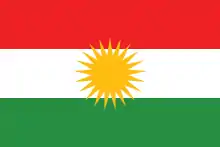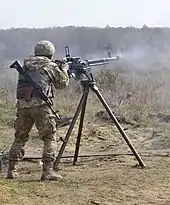DShK
The DShK 1938 (Cyrillic: ДШК, for Russian: Дегтярёва-Шпагина Крупнокалиберный, romanized: Degtyaryova-Shpagina Krupnokaliberny, "Degtyaryov-Shpagin large-calibre") is a Soviet heavy machine gun with a V-shaped butterfly trigger, firing the 12.7×108mm cartridge. The weapon was also used as a heavy infantry machine gun, where it was frequently deployed with a two-wheeled mounting and a single-sheet armour-plate shield. The DShK's name is derived from its original designer, Vasily Degtyaryov, and Georgi Shpagin, who later improved the cartridge feed mechanism. It is sometimes nicknamed Dushka (a dear or beloved person) in Russian-speaking countries, from the abbreviation.[15] Alongside the American M2 Browning, the DShK is the only .50 caliber machine gun designed prior to World War II that remains in service to the present day.[16]
| DShK | |
|---|---|
 A Romanian DShK on display at Expomil 2005. | |
| Type | Heavy machine gun |
| Place of origin | Soviet Union |
| Service history | |
| In service | 1938–present |
| Used by | See Users |
| Wars | Winter War World War II Korean War Chinese Civil War First Indochina War Operation Trikora Indonesia–Malaysia confrontation Vietnam War Laotian Civil War Dhofar Rebellion Cambodian Civil War Cambodian-Vietnamese War Sino-Vietnamese War Six-Day War Yom Kippur War Western Sahara War[1] Angolan Civil War[2] Iran–Iraq War The Troubles Lebanese Civil War[3] Chadian–Libyan conflict[4] Somali Civil War[5] Tuareg rebellion (1990–1995)[6] Gulf War Yugoslav Wars Rwandan Civil War[7] Kargil War Iraq War[8] Wars in Afghanistan[9] Cambodian–Thai border dispute Operation Enduring Freedom Liberian Civil Wars Operation Linda Nchi Chechen Wars[5] First Libyan Civil War[10] Northern Mali conflict[11] Second Libyan Civil War 2014 pro-Russian conflict in Ukraine South African Border War Syrian Civil War[12] Sri Lankan Civil War Iraqi Civil War (2014–2017)[13] Yemeni Civil War (2015–present)[14] Conflict in Najran, Jizan and Asir 2022 Russian invasion of Ukraine |
| Production history | |
| Designer | Vasily Degtyaryov, Georgi Shpagin |
| Designed | 1938 |
| Manufacturer | Tula Arms Plant |
| Unit cost | US$2,250 (2012) |
| No. built | 1,000,000 |
| Variants | DShK 38/46 Type 54 |
| Specifications | |
| Mass | 34 kg (74 lb 15 oz) (gun only) 157 kg (346 lb 2 oz) on wheeled mounting |
| Length | 1,625 mm (5 ft 4.0 in) |
| Barrel length | 1,070 mm (42.1 in) |
| Cartridge | 12.7×108mm |
| Action | Gas-operated, flapper locking |
| Rate of fire | 600 rounds/min |
| Muzzle velocity | 850 m/s (2,800 ft/s) |
| Effective firing range | 2,000 m (2,200 yd) |
| Maximum firing range | 2,500 m (2,700 yd) |
| Feed system | 50 round belt |
| Sights | Iron/optical |
History
Requiring a heavy machine gun similar to the M2 Browning, development of the DShK began in the Soviet Union in 1929 and the first design was finalised by Vasily Degtyaryov in 1931.[17][18] The initial design used the same gas operation from the Degtyaryov machine gun, and used a 30 round drum magazine, but had a poor rate of fire. Georgy Shpagin revised the design by changing it to a belt-fed with a rotary-feed cylinder, and the new machine gun began production in 1938 as the DShK 1938.[17][19]
During World War II, the DShK was used by the Red Army, with a total of 9,000 produced during the war.[17] It was used mostly in anti-aircraft roles on vehicles such as the GAZ-AA truck, JS-2 tank, ISU-152 self-propelled artillery, and the T-40 amphibious tank.[17] Similar to the PM M1910 Maxim, when deployed against infantry, the DShK was used with a two-wheeled trolley, with which the machine gun weighed a total of 346 pounds (157 kg).[20] After 1945, the DShK was exported widely to other countries in the Eastern Bloc.[21]
In 1946, an improved variant was produced, with a revised muzzle and feeding system. Named the DShK 38/46 or DShK-M, over a million were produced from 1946-1980.[17] The gun was also revised to become more reliable, and easier to manufacture.[22] The new DShK was produced under license in Pakistan, Iran, Yugoslavia, Romania and Czechoslovakia.[17] China produced their own variant of the design, designated the Type 54.[23]
After World War II, DShKs were used widely by communist forces in Vietnam, starting with the Battle of Dien Bien Phu in 1954. While not as powerful as anti-aircraft cannons, the DShK was easier to smuggle through Vietnam, Cambodia and Laos.[17] DShKs were a major threat to American aircraft in the Vietnam War,[21] and of the 7,500 helicopters and fixed-wing aircraft lost during the war, most were destroyed by DShKs.[17]
In June 1988, during The Troubles, a British Army Westland Lynx helicopter was hit 15 times by two Provisional IRA DShKs smuggled from Libya, and forced to crash-land near Cashel Lough Upper, south County Armagh.[24]
DShKs were also used in 2004, against British troops in Al-Amarah, Iraq.[25]
Rebel forces utilized DShKs in the Syrian civil war, often mounting the gun on cars. In 2012, the Syrian government claimed to have destroyed 40 such technicals on a highway in Aleppo and six in Dael.[26]
The DShK began to be partially replaced in the Soviet Union by the NSV machine gun in 1971, and the Kord machine gun in 1998.[16] The DShK remains in service, although it is no longer produced.[27]
Design
The DShK is a belt-fed machine gun that uses a butterfly trigger.[21] Firing the 12.7×108mm cartridge at 600 rounds per minute, it has an effective range of 2.4 km (1+1⁄2 mi), and can penetrate up to 20 mm of armor up to a range of 500 m.[17] The DShK has two "spider web" ring sights for use against aircraft. It is used by infantry on tripod mounts, and is deployed on tanks and armored vehicles for use against infantry and aircraft; nearly all Russian-designed tanks use the DShK.[27]
Users
 Afghanistan[28]
Afghanistan[28] Albania[28] "DShkM" locally produced from a Chinese copy
Albania[28] "DShkM" locally produced from a Chinese copy Algeria[28]
Algeria[28] Angola[28]
Angola[28] Armenia[28]
Armenia[28] Azerbaijan[28]
Azerbaijan[28] Bangladesh[28] Type 54.
Bangladesh[28] Type 54. Belarus[28]
Belarus[28] Bulgaria[28]
Bulgaria[28] Burkina Faso[11]
Burkina Faso[11] Burundi[29]
Burundi[29] Cambodia[28]
Cambodia[28] Cameroon[30]
Cameroon[30] Cape Verde[28]
Cape Verde[28] Central African Republic[28]
Central African Republic[28] Chad[28]
Chad[28] Chile[31]
Chile[31] China: Produced DShKM variant.[32]
China: Produced DShKM variant.[32] Congo-Brazzaville[28]
Congo-Brazzaville[28] Congo-Kinshasa[28][33]
Congo-Kinshasa[28][33] Cuba[28]
Cuba[28] Cyprus[28]
Cyprus[28] Czechoslovakia: Produced DShKM variant TK Vz.53 which included a four barrelled version.[32]
Czechoslovakia: Produced DShKM variant TK Vz.53 which included a four barrelled version.[32] Czech Republic[28]
Czech Republic[28] East Germany[34]
East Germany[34] Egypt[28]
Egypt[28] Equatorial Guinea[28]
Equatorial Guinea[28] Eritrea[28]
Eritrea[28] Ethiopia[28]
Ethiopia[28] Finland[28]
Finland[28] Georgia[28]
Georgia[28] Ghana[28]
Ghana[28] Guinea[28]
Guinea[28] Guinea-Bissau[28]
Guinea-Bissau[28] Hungary[28]
Hungary[28] Indonesia[28]
Indonesia[28] Iran: Manufactured DShKM variant named MGD 12.7.[35][36]
Iran: Manufactured DShKM variant named MGD 12.7.[35][36] Iraq[28] called the "Doshka" by Iraqis
Iraq[28] called the "Doshka" by Iraqis
 Iraqi Kurdistan[37]
Iraqi Kurdistan[37]
 Islamic State
Islamic State Israel[28]
Israel[28] India Captured during Kargil War
India Captured during Kargil War Côte d'Ivoire[38]
Côte d'Ivoire[38] Kazakhstan[28]
Kazakhstan[28] Kenya[39]
Kenya[39] Kosovo
Kosovo Kyrgyzstan[28]
Kyrgyzstan[28] Laos[28]
Laos[28] Liberia[40]
Liberia[40] Libya[28]
Libya[28] Lithuania[28]
Lithuania[28] Macedonia[28]
Macedonia[28] Madagascar[28]
Madagascar[28] Mali[28] – Armed and Security Forces of Mali
Mali[28] – Armed and Security Forces of Mali Malta[28]
Malta[28] Mongolia[41]
Mongolia[41] Mozambique[28]
Mozambique[28] Nicaragua[28]
Nicaragua[28] Niger
Niger Nigeria[28]
Nigeria[28] North Korea[28]
North Korea[28].svg.png.webp) North Vietnam[32]
North Vietnam[32] Pakistan: Used by the Pakistan Army. DShKM variant produced locally.[42][43]
Pakistan: Used by the Pakistan Army. DShKM variant produced locally.[42][43] Peru[28]
Peru[28] Poland Produced locally[44][45]
Poland Produced locally[44][45] Palestine
Palestine Romania Produced locally[46] (still used with TR-85 tanks)
Romania Produced locally[46] (still used with TR-85 tanks) Russia[28]
Russia[28] Rwanda: Used by Rwandan Peacekeepers in Darfur.
Rwanda: Used by Rwandan Peacekeepers in Darfur. Saudi Arabia
Saudi Arabia Serbia[28]
Serbia[28] Seychelles[28]
Seychelles[28] Sierra Leone[28]
Sierra Leone[28] Slovakia[28]
Slovakia[28] Somalia[28]
Somalia[28] Sahrawi Arab Democratic Republic[1]
Sahrawi Arab Democratic Republic[1] South Sudan[47]
South Sudan[47] Soviet Union: Passed on to successor states.[32]
Soviet Union: Passed on to successor states.[32] Sudan
Sudan Syria[28]
Syria[28] Sri Lanka: Used by Tamil Tigers. (former user)
Sri Lanka: Used by Tamil Tigers. (former user) Tanzania[28]
Tanzania[28] Togo[28]
Togo[28] Turkey[48]
Turkey[48] Turkmenistan[28]
Turkmenistan[28] Uganda[28]
Uganda[28] Ukraine: Also produces a variant with a bipod and large muzzle brake for infantry usage[28][49]
Ukraine: Also produces a variant with a bipod and large muzzle brake for infantry usage[28][49] Vietnam[28]
Vietnam[28] Yemen[28]
Yemen[28].svg.png.webp) Yugoslavia: Manufactured DShKM variant.[35]
Yugoslavia: Manufactured DShKM variant.[35] Zambia[28]
Zambia[28] Zimbabwe[28]
Zimbabwe[28]
Non-state users
Gallery
 A soldier with the Ukrainian Land Forces fires a DShKM
A soldier with the Ukrainian Land Forces fires a DShKM.jpg.webp) DShKM TR-85M1
DShKM TR-85M1 DShKM URO VAMTAC
DShKM URO VAMTAC DShK M1938
DShK M1938 DShKM anti-aircraft machine gun on a T-55 tank loader's roof hatch
DShKM anti-aircraft machine gun on a T-55 tank loader's roof hatch The M53 is an anti-aircraft mounting of four 12.7 mm heavy machine guns vz. 38/46 (Czech copy of Soviet DShKM)
The M53 is an anti-aircraft mounting of four 12.7 mm heavy machine guns vz. 38/46 (Czech copy of Soviet DShKM) Ukrainian soldier firing from a modified DShKM with bipod and pistol grip
Ukrainian soldier firing from a modified DShKM with bipod and pistol grip
See also
- FN BRG-15
- HMG PK-16
- KPV heavy machine gun
- List of Russian weaponry
References
- Francesco Palmas (2012). "Il contenzioso del sahara occidentale fra passato e presente" (PDF). Informazioni della Difesa (in Italian). No. 4. pp. 50–59. Archived (PDF) from the original on 2018-06-12. Retrieved 2018-06-12.
- Fitzsimmons, Scott (November 2012). "Executive Outcomes Defeats UNITA". Mercenaries in Asymmetric Conflicts. Cambridge University Press. p. 217. doi:10.1017/CBO9781139208727.006. ISBN 9781107026919.
- Neville, Leigh (19 Apr 2018). Technicals: Non-Standard Tactical Vehicles from the Great Toyota War to modern Special Forces. New Vanguard 257. Osprey Publishing. p. 15. ISBN 9781472822512. Archived from the original on 26 October 2018. Retrieved 25 October 2018.
- Neville 2018, p. 16.
- Neville 2018, p. 24.
- Small Arms Survey (2005). "Sourcing the Tools of War: Small Arms Supplies to Conflict Zones". Small Arms Survey 2005: Weapons at War. Oxford University Press. p. 166. ISBN 978-0-19-928085-8. Archived from the original (PDF) on 2018-08-30. Retrieved 2018-08-29.
- "Rwandan government soldiers fire 12 June 1994 heavy artillery at".
- Neville 2018, p. 30.
- Neville 2018, p. 26.
- Neville 2018, p. 35.
- Cherisey, Erwan de (July 2019). "El batallón de infantería "Badenya" de Burkina Faso en Mali - Noticias Defensa En abierto". Revista Defensa (in Spanish) (495–496).
- Neville 2018, p. 37.
- Vining, Miles (May 7, 2018). "ISOF Arms & Equipment Part 3 – Machine Guns". armamentresearch.com. Archived from the original on September 25, 2018. Retrieved October 1, 2018.
- Neville 2018, p. 38.
- Erik Lawrence (2015). Practical Guide to the Operational Use of the DShK & DShKM Machine Gun. Erik Lawrence Publications. p. 10. ISBN 978-1-941998-22-9.
- Rottman, Gordon (2010). Browning .50-caliber Machine Guns. Osprey Publishing. p. 72.
- Roblin, Sebastien (2018-11-10). "How a Deadly Russian World War II .50 Caliber Machine Gun Blasted its Mark into History". The National Interest. Retrieved 2021-12-03.
- Willbanks, James (2004). Machine Guns: An Illustrated History of Their Impact. ABC-CLIO. p. 200.
- Willbanks 2004, p. 109.
- "Finnish Army 1918–1945: Antiaircraft Machineguns". Archived from the original on 29 November 2014. Retrieved 15 December 2014.
- Larson, Caleb (2021-02-03). "The Soviet DShK Heavy Machine Gun Won't Go Away". The National Interest. Retrieved 2021-12-03.
- Willbanks 2004, p. 121.
- Small Arms Survey (2008). "Light Weapons: Products, Producers, and Proliferation". Small Arms Survey 2008: Risk and Resilience. Cambridge University Press. p. 21. ISBN 978-0-521-88040-4. Archived from the original (PDF) on 2018-08-30. Retrieved 2018-08-30.
- Harnden, Toby (2000).Bandit Country: The IRA and South Armagh. Coronet Books, pp. 360–361 ISBN 0-340-71737-8
- Mills, Dan (2007). "16". Sniper One. Penguin Group. p. 192. ISBN 978-0-7181-4994-9.
They were Dshkes, a Russian-made beast of a thing that fires half-inch calibre rounds and was designed to bring down helicopters.
- "الوكالة العربية السورية للأنباء". Archived from the original on 12 November 2013. Retrieved 15 December 2014.
- Willbanks 2004, p. 134.
- Jones, Richard D.; Ness, Leland S., eds. (January 27, 2009). Jane's Infantry Weapons 2009/2010 (35th ed.). Coulsdon: Jane's Information Group. ISBN 978-0-7106-2869-5.
- Thierry Vircoulon (2014-10-02). "Insights from the Burundian Crisis (I): An Army Divided and Losing its Way". International Crisis Group. Archived from the original on 2017-05-21. Retrieved 2017-06-12.
- "Cameroon air strikes on Boko Haram". BBC News. 29 December 2014. Archived from the original on 30 April 2018. Retrieved 19 March 2018.
- Gander, Terry J.; Hogg, Ian V. Jane's Infantry Weapons 1995/1996. Jane's Information Group; 21 edition (May 1995). ISBN 978-0-7106-1241-0.
- Miller, David (2001). The Illustrated Directory of 20th Century Guns. London: Salamander Books Ltd. ISBN 978-1-84065-245-1.
- Army Recognition (2008-10-30). "Democratic Republic Congo Ranks combat uniforms Congolese army". armyrecognition.com. Archived from the original on 2017-06-02. Retrieved 2017-06-22.
- "12,7-mm-überschweres Maschinengewehr DSchK Modell 1938 und Modell 1938/46". Militaertechnik der NVA (in German).
- "G3 Defence Magazine August 2010". calameo.com. Archived from the original on July 9, 2012. Retrieved 15 December 2014.
- Neville 2018, p. 9.
- NRT (2017-01-25). "Peshmerga Ministry: There will be no withdraw from liberated areas". NRT TV. Retrieved 2017-06-25.
- de Tessières, Savannah (April 2012). Enquête nationale sur les armes légères et de petit calibre en Côte d'Ivoire: les défis du contrôle des armes et de la lutte contre la violence armée avant la crise post-électorale (PDF) (Report). Special Report No. 14 (in French). UNDP, Commission Nationale de Lutte contre la Prolifération et la Circulation Illicite des Armes Légères et de Petit Calibre and Small Arms Survey. p. 97. Archived from the original (PDF) on 2018-10-09. Retrieved 2018-08-30.
- World Armies (2012-10-08). "Kenyan Army". flicker. Archived from the original on 2017-04-06. Retrieved 2017-04-05.
- Small Arms Survey (2005). "Sourcing the Tools of War: Small Arms Supplies to Conflict Zones". Small Arms Survey 2005: Weapons at War. Oxford University Press. p. 167. ISBN 978-0-19-928085-8. Archived from the original (PDF) on 2018-08-30. Retrieved 2018-08-29.
- Mongolian military museum. Ulaanbaatar. Sights of intersest Archived 2013-11-06 at the Wayback Machine
- O'Halloran, Kevin (2012). Rwanda: Unamir 1994/1995. Big Sky Publishing. ISBN 978-1-921941-48-1.
- "12.7mm DShK heavy machinegun". Archived from the original on 16 May 2013. Retrieved 15 May 2013.
- "65 lat dostaw uzbrojenia z Tarnowa". 3 June 2018.
- "65 Years of Armament Production in Tarnow". 4 September 2020.
- Gander, Terry J. (4 May 2001). "ROMARM machine guns". Jane's Infantry Weapons 2002-2003. p. 3407.
- Small Arms Survey (2014). "Weapons tracing in Sudan and South Sudan" (PDF). Small Arms Survey 2014: Women and guns (PDF). Cambridge University Press. p. 224. Archived from the original (PDF) on 2016-10-14. Retrieved 2018-08-29.
- "Reported use by intelligence agency". Archived from the original on 2016-07-24.
- "Ukrainian Modified DShK with Buttstock, Picatinny Rail, and Bipod in Ground Role". The Firearm Blog. 19 December 2017.
Further reading
- Leszek Erenfeicht (29 August 2012). "Dushka: The Soviet Fifty Caliber". Small Arms Defense Journal. Vol. 4, No. 3.
- Koll, Christian (2009). Soviet Cannon: A Comprehensive Study of Soviet Arms and Ammunition in Calibres 12.7mm to 57mm. Austria: Koll. p. 53. ISBN 978-3-200-01445-9.
External links
- DShK and DShKM at guns.ru.
- Video of Operation